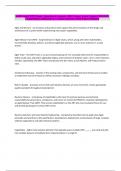SAFE Agile POPM Exam | Questions & Answers (100 %Score) Latest Updated 2024/2025
Comprehensive Questions A+ Graded Answers | With Expert Solutions
Agile Architecture - set of values and practices that support the active evolution of the design and
architecture of a system while implementing new system capabilities.
Agile Release Train (ART) - long-lived team of Agile teams, which, along with other stakeholders,
incrementally develops, delivers, and where applicable operates, one or more solutions in a value
stream.
Agile Team - The SAFe Team is a cross-functional group of 5 to 11 people who have the responsibility to
define, build, test, and where applicable deploy, some element of Solution value—all in a short Iteration
timebox. Specifically, the SAFe Team incorporates the Dev Team, Scrum Master, and Product Owner
roles.
Architectural Runway - consists of the existing code, components, and technical infrastructure needed
to implement near-term features without excessive redesign and delay.
Built-In Quality - practices ensure that each Solution element, at every increment, meets appropriate
quality standards throughout development.
Business Owners - small group of stakeholders who have the primary business and technical
responsibility for governance, compliance, and return on investment (ROI) for a Solution developed by
an Agile Release Train (ART). They are key stakeholders on the ART who must evaluate fitness for use
and actively participate in certain ART events.
Business Solutions and Lean Systems Engineering - competency describes how to apply Lean-Agile
principles and practices to the specification, development, deployment, and evolution of large, complex
software applications and cyber-physical systems.
Capabilities - higher-level solution behavior that typically spans multiple ARTs. _____ are sized and split
into multiple features to facilitate their implementation in a single PI.
, Communities of Practice (CoPs) - organized groups of people who have a common interest in a specific
technical or business domain. They collaborate regularly to share information, improve their skills, and
actively work on advancing the general knowledge of the domain.
Compliance - strategy and a set of activities and artifacts that allow teams to apply Lean-Agile
development methods to build systems that have the highest possible quality, while simultaneously
assuring they meet any regulatory, industry, or other relevant standards.
Continuous Delivery Pipeline - represents the workflows, activities, and automation needed to shepherd
a new piece of functionality all the way from ideation to an on-demand release of value to the end user.
Continuous Deployment (CD) - process that takes validated Features from a staging environment and
deploys them into the production environment, where they are readied for release.
Continuous Exploration (CE) - process that fosters innovation and builds alignment on what should be
built by continually exploring market and Customer needs, and defining a Vision, Roadmap, and set of
Features for a Solution that addresses those needs.
Continuous Integration (CI) - process of taking features from the Program Backlog and developing,
testing, integrating, and validating them in a staging environment where they are ready for deployment
and release.
Core Values - alignment, built-in quality, transparency, and program execution represent the
fundamental beliefs that are key to SAFe's effectiveness. These guiding principles help dictate behavior
and action for everyone who participates in a SAFe portfolio.
Customers - ultimate buyer of every Solution. They are an integral part of the Lean-Agile development
process and the Value Stream and have specific responsibilities in SAFe.
Dev Team - subset of the Agile Team. It consists of dedicated professionals who can develop, test, and
deploy a Story, Feature, or component. The __ __ typically includes software developers and testers,
engineers, and other dedicated specialists required to complete a vertical slice of functionality.




